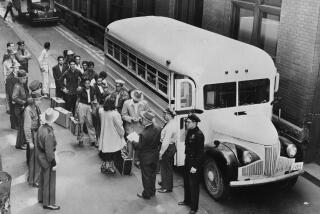Bill to Expand Encino Park Stalls in Hearing
SACRAMENTO — A bill to spend $11 million to expand Los Encinos State Historic Park in Encino and begin planning a museum to document San Fernando Valley history, from prehistoric Indian villages to the Ventura Freeway, stalled in its first legislative hearing this week.
In the face of opposition from the state Department of Parks and Recreation, Sen. Alan Robbins (D-Van Nuys), author of the bill, asked the Senate Natural Resources Committee Tuesday to postpone voting on his measure until next month.
Meantime, Robbins said he may scale down his proposal to seek only $500,000 to catalogue and preserve Indian artifacts unearthed last summer at a construction site across the street from the park, which is on Ventura Boulevard at Balboa Boulevard in an area rapidly being filled with high-rises.
Bill Termed ‘Premature’
Robbins said he also may amend the bill to allow the Legislature to signal its support for building the museum within two or three years rather than immediately.
Marilyn Olson, chief legislative coordinator for the Parks Department, described the bill as “premature” because Los Encinos’ expansion has been given a lower priority for state park funds. She said more than 100 projects in the state were ranked ahead of the Los Encinos expansion.
Olson said she was uncertain if the department could go along with Robbins’ compromise proposal.
“It’s so open-ended and ill-defined, and we haven’t taken a position on whether there is a need for a museum” at the park, she said, adding that the department would, in any case, work with Robbins to preserve the artifacts.
Relics Recovered
Robbins introduced his bill after bones and Indian relics of the “Lost Village of Encino” were dug up at the construction site of a high-rise office building at the southeastern corner of Ventura and Balboa boulevards.
Nancy A. Whitney-Desautels, whose company oversaw archeological excavation at the site, told the committee Tuesday that the collection of artifacts, dating from 5000 BC to AD 1800, “will represent the largest single collection of California Indian artifacts from one site” in the state.
Indian groups wanted to bury the remains of Indians found on the site as close to the village site as possible. The park, created in 1949, contains three of the oldest buildings in the San Fernando Valley.
Robbins introduced the bill to earmark $8 million to purchase about three acres next to the park, which now contains a Pic ‘N’ Save store, several other businesses and a parking lot. Up to $3 million more would be used to preserve the artifacts and draw up plans for the museum.
Robbins estimated that the museum building could cost another $5 million, meaning the total price tag for the project could rise to $16 million.
More to Read
Sign up for Essential California
The most important California stories and recommendations in your inbox every morning.
You may occasionally receive promotional content from the Los Angeles Times.










